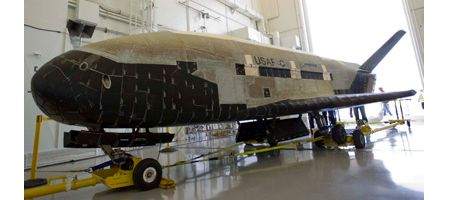After a record-breaking 15-month secret mission, the US Air Force’s X-37 B robotic space plane has touched down at Vandenberg Air Force Base in California.

Also known as Orbital Test Vehicle-2 (OTV-2), it’s the successor to OTV-1, which was the US’ first unmanned vehicle to return from space and land on its own. With the space shuttles now out of commission, they’re now the only confirmed space vehicles capable of being reused, although China’s rumored to have something similar.
The X-37 B is 29 feet long and just under ten feet high, with two stubby tail fins, and weighs 11,000 pounds. Built by Boeing, it was launched on March 5 last year atop an Atlas 5 rocket.
Initially designed to stay aloft for nine months, it had its mission extended in December, drawing power from its solar panels.
During its flight, the spaceplane has been carrying out unspecified experiments, with its low orbit implying to some that it’s been being used as a spyplane.
“We congratulate the Air Force Rapid Capabilities Office and the 30th Space Wing at Vandenberg Air Force Base on this second successful mission,” says Paul Rusnock, Boeing vice president of Government Space Systems.
“With OTV-1, we proved that unmanned space vehicles can be sent into orbit and safely recovered. With OTV-2, we tested the vehicle design even further by extending the 220-day mission duration of the first vehicle, and testing additional capabilities.”
A second launch of OTV-1 is planned for later this year, with another OTV-2 flight expected next year.






